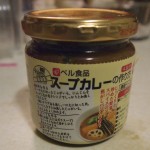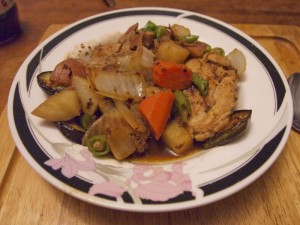Soup curry is quite popular in Hokkaido, a viable alternative to warm the body from both within your belly, and from your tongue. The name is an appropriate descriptor, it is somewhere between a soup and stew/curry. The broth is thin like a soup, but is spiced like a curry. It’s gotten so popular that like ramen, there exists a soup curry yokocho (alley) where you can find shop right next to shop next to shop all serving soup curry. This past winter I made it to Hokkaido to ride the powder and was fortunate to have friends lead me to one soup curry joint that was quite enjoyable.  After that experience, everytime I went food shopping I’d keep my eyes open to see if some company would create a soup curry mix just like you can get the wafu style curry roux blocks everywhere. No such luck. I chocked it up to the thought that it hadn’t gained enough mainstream popularity elsewhere in Japan to gain the attention of the food manufacturers. Until tonight. Part of the problem was I was looking for the wrong thing. Tucked out of eye level sightline on the top shelf at Marukai was this small 6 oz. jar of soup curry paste. Had to pay attention as there was no English characters, but there it was. I checked it out, pork and chicken fat were the top ingredients, how can you go wrong with that? The only thing that was holding me back was the latest best buy date looked to be 5/30/09. Three months…. The stuff is chock full of salt…. The cap wasn’t bulging…. It should be okay….
After that experience, everytime I went food shopping I’d keep my eyes open to see if some company would create a soup curry mix just like you can get the wafu style curry roux blocks everywhere. No such luck. I chocked it up to the thought that it hadn’t gained enough mainstream popularity elsewhere in Japan to gain the attention of the food manufacturers. Until tonight. Part of the problem was I was looking for the wrong thing. Tucked out of eye level sightline on the top shelf at Marukai was this small 6 oz. jar of soup curry paste. Had to pay attention as there was no English characters, but there it was. I checked it out, pork and chicken fat were the top ingredients, how can you go wrong with that? The only thing that was holding me back was the latest best buy date looked to be 5/30/09. Three months…. The stuff is chock full of salt…. The cap wasn’t bulging…. It should be okay….
So I finally had my meal plan for tonight. Grabbed some shishito peppers and booze and I was on my way out. Other veggie selections were weak so I decided to make a stop at Foodland to round it out. Grabed some chicken thigh out of freezer and started that thawing and some rice soaking. Then set out to decode the instructions. Decided to go ask my dad instead of spending the next hour trying to read it. The instructions weren’t incredibly helpful and pretty much was how I figured it would go. It suggested using the microwave to precook potato and carrots, which was excellent advice. By the time I got all the veggies prepped, the chicken was thawed. A little s&p and into a hot pan it went. Get some browning going, and after it progressed quite a ways, toss in some eggplant discs and onion to get them cooked well. I like to get a nice browning on the eggplant. Once the chicken was cooked through, reserved everything out of the pan on the side. Into the pan went the potato, carrot and shishito. Cook enough to get some browning and some of those flavors to join the party, then throw some water in to deglaze all the goodness and get the soup part of soup curry going. Into the mixture went a couple conservative teaspoons of the paste. Wasn’t sure how much to use, easy enough to add more. Turns out this is fairly strong stuff and it didn’t require any more. In retrospect could have used more water and paste to make more soup. This jar is supposed to make four servings, I think I barely used an eigth of it.
The reserved ingredients rejoined the happy soup to warm back up and get some of that curry goodness into the chicken. Let that bubble away for a short while, dinner is served!
Went a bit overboard on the veggies. The restaurant soup curry you see only has a smattering of veggies, making for nice presentation. Just think of mine as hearty homestyle. So the verdict? This paste is the medium spicy. Quite yummy, spicy enough to make it tasty, but not enough to get the endorphins flowing. Have to say, this is a winnah!
3.5 out of 4 curry monkeys!

In general, most places in Sapporo precook the vegetables by deep frying. In the case of things like okra, shishito, and eggplant, this preserves the color. This does however tend to make things like broccoli oily and mushy. Supposedly the origins of soup-curry are East of India, but West of Vietnam – Bangladesh often getting the credit for it.
Yeah, didn’t want to bust out another pan and pile of oil to do the deep fry of veggies.
I personally dislike having the vegetables fried. The information was provided only for educational purposes.